HII regions and High mass star formation
Research
High mass stars (stars more massive than 8 times the mass of the Sun) emit ultraviolet photons that ionize the hydrogen, creating ionized (HII) regions.
The Spitzer satellite images of the Galactic Plane revealed that we live in a bubbling Galactic disk.
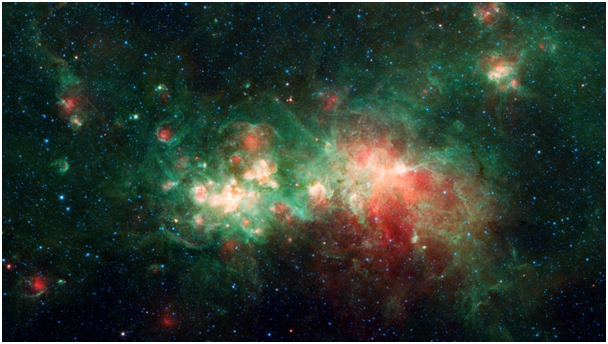
HII regions expand in the interstellar medium. The expansion is supersonic and creates a shock front (SF) that developes ahead of the ionization front (IF) during the expansion. Matter (gas and dust) is accumulated between the IF and SF and will allow the formation of a new generation of stars, as predicted by the theory (Elmegreen and Lada, 1977, Whitworth et al. 1994) and observed (Deharveng et al. 2003, 2005, Zavagno et al. 2007, 2010 ……). This phenomenon is called induced or triggered star formation.
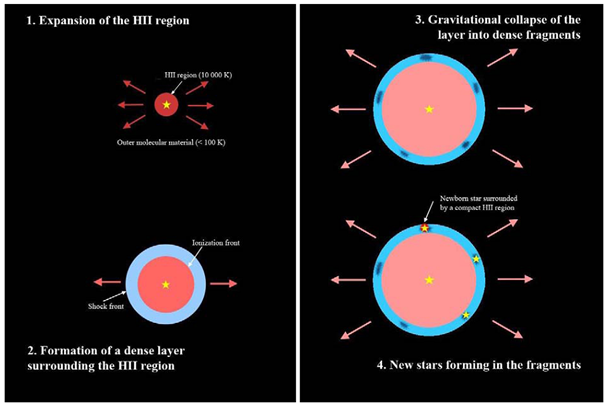
A schematic view of the way HII regions’ expansion can lead to the formation of a new generation of stars. (Deharveng, Zavagno)
Many physical mechanisms can lead to the formation of a new generation of stars at the edges of HII regions. Those mainly depends on the density of the material (gas and dust) that surrounds the ionized region when it expands (see Fig. 4 in Deharveng et al. 2010).
The properties of stars (the ones responsible for the formation of the HII region and the young ones observed at the edges of it) have been studied using near infrared integral field spectroscopy with SINFONI on the VLT (Martins et al. 2010). This study shows the two distinct population of stars and ascertain their respective properties. This is key to demonstrate the causal link between the first and the second generation of stars. This study shows the diversity of spectroscopic signatures detected in the young stellar objects observed at the edges of the studied Galactic HII regions, RCW 79, RCW 82 and RCW 120.
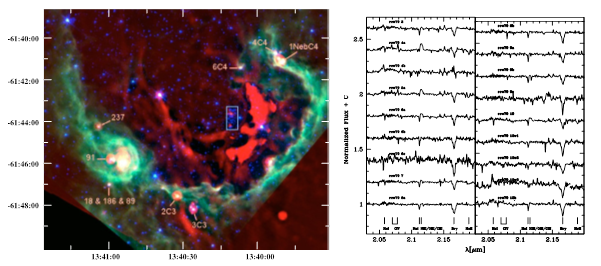
Stars identification in RCW 79 for the VLT-SINFONI spectroscopic study (left) and spectra of the ionizing stars (located in the white rectangle) (right) (Martins et al. 2010).
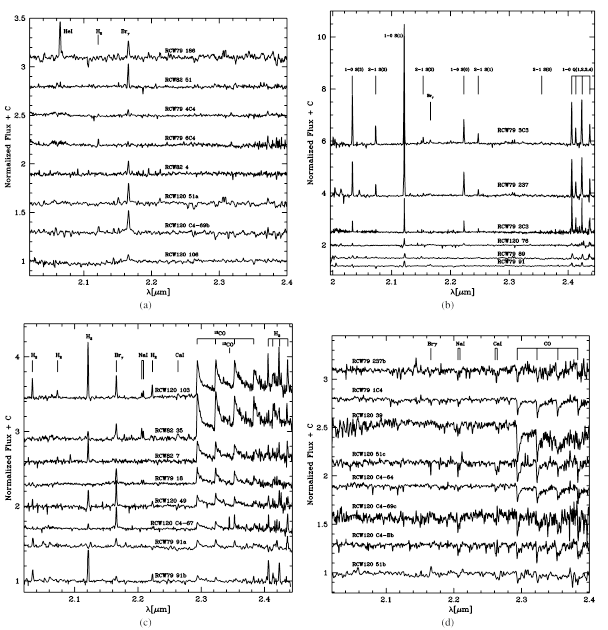
Diversity of near-IR spectra of young stellar objects located at the edges of the Galactic HII regions RCW79, RCW 82 and RCW 120, observed with VLT-SINFONI (Martins et al. 2010).
Using Herschel and multi wavelength observations we show that HII regions’ edges host high-mass star formation in different evolution stages (Deharveng et al. 2003, Zavagno et al. 2006, Zavagno et al. 2010a,b, Figueira et al. 2017, Liu et al. 2017, Tigé et al. 2017).
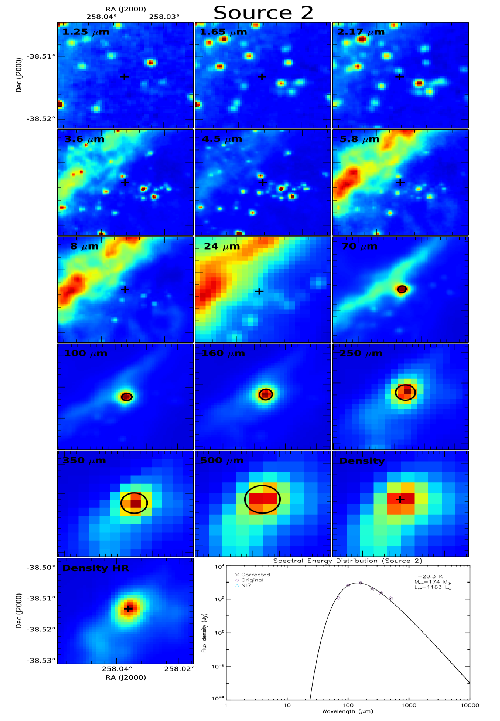
Study of point sources observed at the edges of RCW 120 (Figueira et al. 2017)
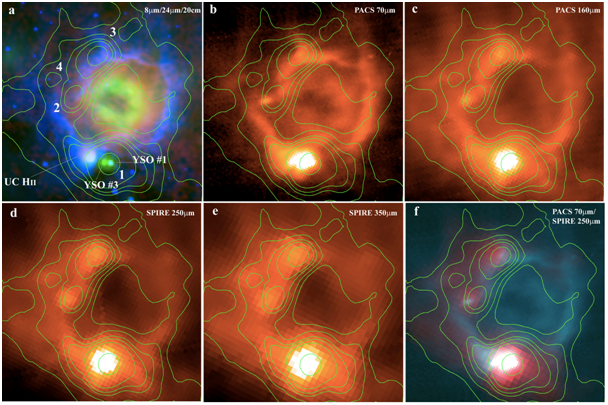
High mass star formation observed at the edges of the Galactic HII region N49 with Herschel (Zavagno et al. 2010b).
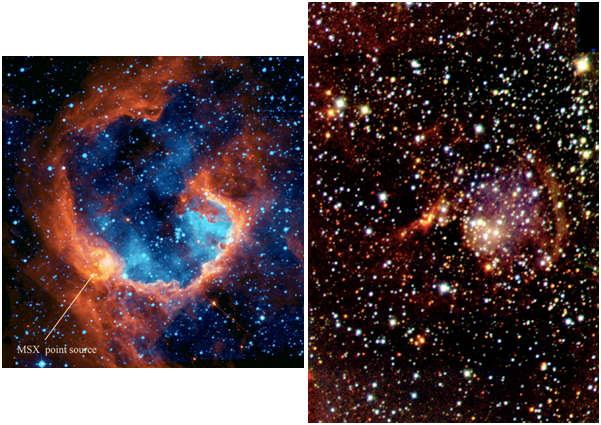
High mass star formation observed at the edges of the Galactic HII region RCW 79 (Zavagno et al. 2006)
Using Herschel Hi-GAL data, Palmeirim et al. (2017) show that an overdensity of young stars (Class 0) is observed at the edges of HII regions, demonstrating the role of HII regions in favoring star formation on the Galactic scale.
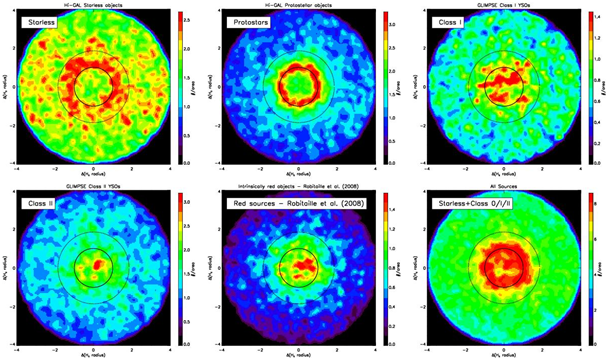
A global study of star formation observed at the edges of HII regions using Hi-GAL data (Palmeirim et al. 2017)
Triggered star formation is also observed in external galaxies and resolved with adaptive optics in the Large Magelanic Cloud (Bernard et al.).
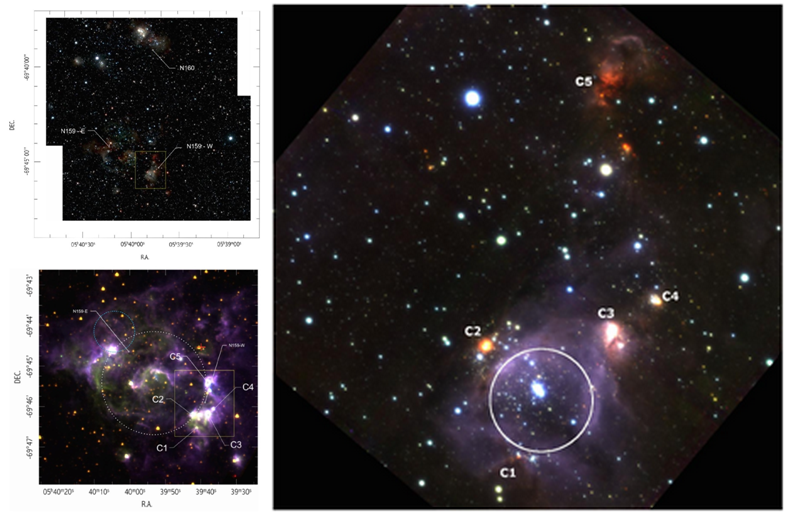
Star formation at the edges of N159 in the Large Magelanic Cloud observed in the near infrared with GEMS on GEMINI, with adaptive optics (Bernard et al. 2016).
ALMA studies reveal the impact of HII regions on small (<0.1 pc) spatial scales and their influence on the earliest stages of star formation. Figueira et al. (2018) show that fragmentation is limited at the edges of RCW 120, leading to high-mass star formation. Star formation at the edges of RCW 120 observed with Herschel at 70 microns (top) and ALMA at 3mm (continuum emission, bottom). High mass star formation occurs in source 1 (Figueira et al. 2018).
Zhang et al. (2020b) study a sample of candidates High Mass Starless Clumps and compare the core contents of HMSCs impacted and non impacted by HII regions (see also Zhang et al. 2020a). This study shows that HII regions influence the star formation in HMSCs by changing the local physical conditions (temperature, density) and the distribution of cores in HMSCs.
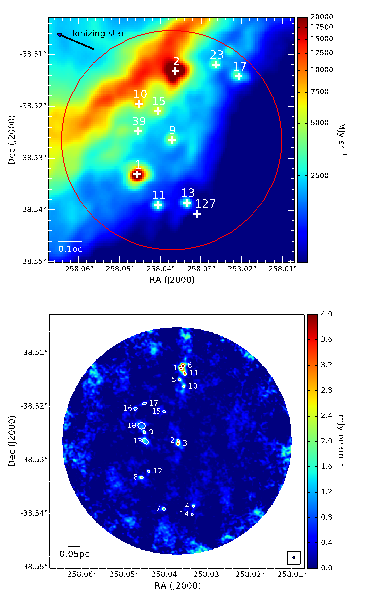
Star formation at the edges of RCW 120 observed with Herschel at 70 microns (top) and ALMA at 3mm (continuum emission, bottom). High mass star formation occurs in source 1 (Figueira et al. 2018).
Zhang et al. (2020b) study a sample of candidates High Mass Starless Clumps and compare the core contents of HMSCs impacted and non impacted by HII regions (see also Zhang et al. 2020a). This study shows that HII regions influence the star formation in HMSCs by changing the local physical conditions (temperature, density) and the distribution of cores in HMSCs.
References
Bernard et al. 2016, A&A, 592, A77
Deharveng et al. 2003, A&A, 408, L25
Deharveng et al. 2005, A&A, 433, 565
Deharveng et al. 2010, A&A, 523, A6
Figueira et al. 2017, A&A 600, A93
Figueira et al. 2018, A&A, 616, L10
Liu et al. 2017, A&A, 602, A95
Martins, F. et al. 2010, A&A, 510, A32
Tigé et al. 2017, A&A, 602, A77
Palmeirim et al. 2017, A&A 605, A35
Zavagno et al. 2006, A&A, 446, 171
Zavagno et al. 2010a, A&A, 518, L81
Zavagno et al. 2010b, A&A, 518, L101
Zhang et al. 2020, A&A, 637, A40
Zhang et al. 2021, A&A, 646, A25
Back to Research page